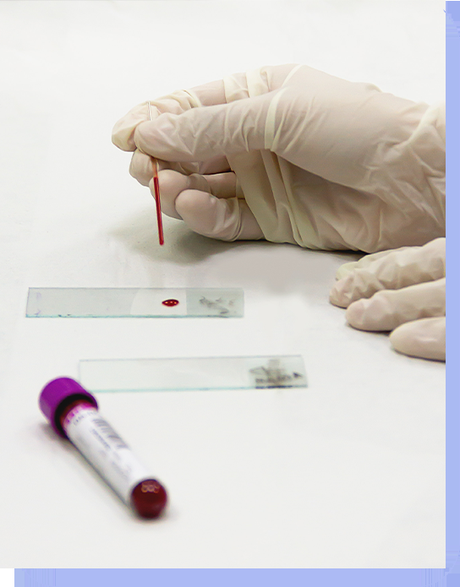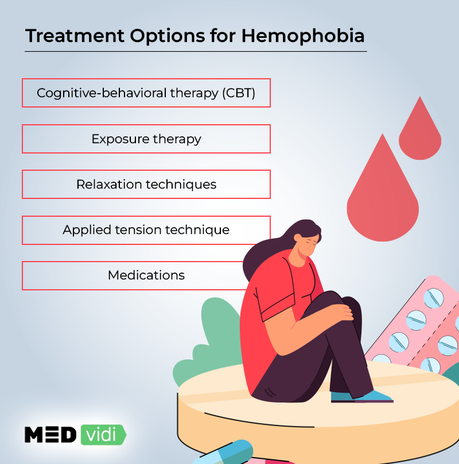Symptoms, Risk Factors, and Treatment
- 9 December, 22
 Phobias
An Overview of Hemophobia: Symptoms, Risk Factors, and Treatment
Phobias
An Overview of Hemophobia: Symptoms, Risk Factors, and Treatment
Phobia is a disorder characterized by an extreme, persistent, and irrational fear of specific objects or situations. People with any phobia feel vulnerable and will go to any length to avoid the source of their anxiety. The main categories include complex phobias (agoraphobia and social phobia) and specific phobias. Hemophobia — a fear of blood — is in the latter category.
The sight or thoughts of blood cause distress or anxiety in people with hemophobia. Moreover, the condition interferes with a patient’s life. For instance, one may skip a doctor’s appointment so as not to take a blood test.
The Diagnostic and Statistical Manual of Mental Disorders (DSM-5) categorizes hemophobia as blood-injection-injury (BBI) phobia. According to the National Institute of Health, the disorder is prevalent since it affects about 3% to 4% of the general population.
Fear of blood can be managed. Book an appointment to see a doctor and get helpful recommendations.
Start Treatment TodayMain Causes and Risk Factors for Blood Phobia
The exact cause of hemophobia is not clear. However, it has been established that anxiety disorders such as hemophobia can pass through bloodlines. A person with a neurotic personality usually overreacts to distress and is likely to develop phobias too.
In some cases, the disorder is a result of direct traumatic experiences or hearing a narration of a frightening experience. It is also possible to acquire the condition by witnessing a blood-associated trauma.
Aside from genetics and traumatic experiences, a few more factors make a person more susceptible to hemophobia. These risk factors include:
- Other psychoneurotic disorders. A person with other psychoneurotic disorders like panic disorder may also develop hemophobia.
- Caregiver’s anxiety. If a caregiver usually gets anxious at the sight of blood, the minor in his/her care may develop similar fears. Eventually, the fear may evolve into a phobia.
- Gender. Women are more likely to have specific phobias than men.
A mental health professional can help you identify the root cause of your anxiety and recommend useful techniques.
Consult A Doctor In 24 HoursHemophobia Symptoms
Hemophobia symptoms are evident if the affected person sees blood. The reactions may be emotional or physical.
Emotional Symptoms:
- Feeling unreal and detached from self
- Extreme anxiety
- Panic attacks
- Feeling as if one could die or pass out
- A powerless and helpless feeling
- An unsettling feeling in the stomach
- Desire to escape or disappear from a scene that has blood
Physical Signs:
- An increase in heart rate
- Chest tightness or pain
- Cold or hot flashes
- Difficulty breathing
- Dizziness or lightheadedness
- Excessive sweating
- Nausea or vomiting
- Trembling or shaking
Although the symptoms of hemophobia may be obvious, only a doctor can make a diagnosis and determine the right treatment.
See A Doctor Online
How to Diagnose Hemophobia
Hemophobia diagnosis involves a psychological evaluation by a mental health practitioner. To make a formal diagnosis, the doctor uses the criteria outlined in the DSM-5.
The seven-point criteria include the following:
- An excessive, persistent, irrational fear of seeing blood.
- The fear of blood persists for at least six months from the first experience.
- Anxiety or panic attacks as a response to the sight of blood.
- The extreme fear of blood is out of proportion to the actual danger it poses.
- Someone actively tries to avoid the sight of blood and has intense distress or anxiety when in a situation with blood.
- The fear of blood interferes with the daily functions of a person.
- The patient’s irrational reactions to blood differ from other specific disorders’ symptoms. The symptoms differ from panic disorder, social phobia, obsessive-compulsive disorder, or post-traumatic stress disorder signs.
Treatment and Management of Hemophobia
Psychotherapy is the most effective treatment for hemophobia. In severe cases, a doctor may include a pharmacological treatment. Therapeutic interventions to treat hemophobia include:
- Cognitive-behavioral therapy (CBT)
This therapy helps a patient understand and confront the irrational fear of blood. It also helps them learn new coping techniques to manage their fears.
- Exposure therapy
The patient is gradually and systematically exposed to experiences that involve blood until he/she develops a coping mechanism to overcome the fear of blood.
- Relaxation techniques
The client learns relaxation techniques like yoga, meditation, and breathing exercises. They use these techniques to release physical tension, diffuse stress and eventually get over the fear of blood.
- Applied tension
The technique is helpful to patients that faint at the sight of blood. In the technique, a person tenses his/her muscles for timed intervals. The exercise happens concurrently with the exposure to the trigger. The tension helps the patient to watch a scene with blood without fainting.
- Medications
When it comes to medications prescribed for hemophobia, the doctor may prescribe selective serotonin reuptake inhibitors (SSRIs), a well-known class of antidepressants.
Conclusion
Hemophobia is a distressful disorder that can interfere with a person’s life. For instance, a patient may not keep medical appointments or be able to help someone in an emergency. People with hemophobia symptoms should seek treatment to be able to have a productive life. If you notice any warning symptoms and want to manage them, MEDvidi doctors are here to help.

Real help for phobias.
Beat your symptoms with our expert advice.





- Fear of blood
- Hemophobia
- Hemophobia symptoms
- How to get over fear of blood
